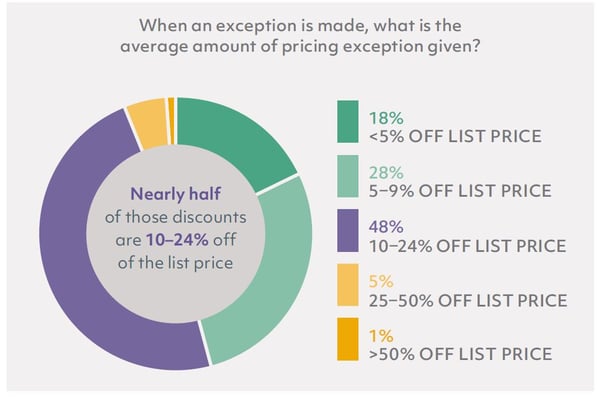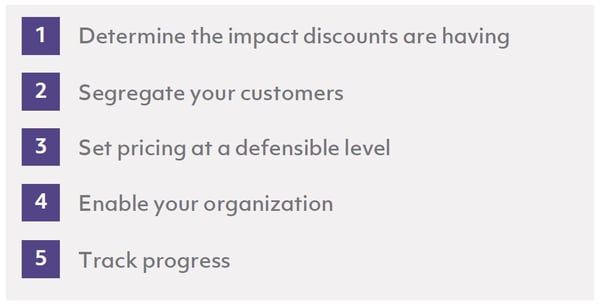
“I just need a 10% discount” is a common refrain salespeople hear from their customers. In the face of these discount requests, given the fear of losing the customer, and the tremendous time invested, the easiest option is to give into their demands, grant the discount, close the deal, and hope for better luck next time. Indeed, that’s what many salespeople would do — and they would be in the majority.
In fact, based on the results of Vantage’s recent study, The Value of Pricing Discipline, of the companies surveyed, nearly 60% indicated that they grant exceptions at least half of the time and a full quarter of companies almost always grant exceptions (75-100% of the time). What’s more astonishing is that nearly half of companies granted pricing exceptions in the range of 10-24% off of their list or standard market price — a tremendous amount of impact when added across all of the deals a sales force makes. Respondents also indicated that over time the situation becomes more dire, as those individual discounts negatively impact the market and value of future deals. 45% of companies granting exceptions saw a decline in overall Average Selling Price (ASP) to the newly discounted price in less than one year after granting the discount. Given the potential impact discounts have on the bottom line, companies would be wise to take steps to mitigate the practice where possible, and at least make sure that discounts are being given for justifiable reasons.

That said, implementing changes to improve pricing discipline is not an overnight approach. It takes strategic planning, cross functional alignment-building, and a change management strategy. Based on the results of the Vantage study, below are five key steps to combat a legacy of discounting:

Companies that are best in class at managing pricing exceptions share common attributes: a clearly well understood process for determining when and why pricing exceptions are granted, salespeople who are able to define and defend the value of their product to customers, a system to track exceptions and adjustments as they are made, and metrics and incentives that are structured to enable sales people to walk away from bad deals.
1. Determine the impact discounts are having — Before entering down this path, companies should try to determine the extent to which discounts are impacting the value of their deals, and the true market consequences making those discounts has had on ASPs. This may require a bit of digging, but it will be worth it, as doing so will uncover the value lost to discounts — and the “size of the pie” to be gained by reigning them in!
2. Segregate your customers — Any effort to change a legacy of discounting will require some tough choices, and may require that you walk from some customers (or expect they will walk from you). Before making any dramatic moves, review your portfolio of customers and categorize them in terms of how critical the relationship is to your business. Specify the profile of customers that your organization is willing to let walk away, those that would not be ideal to lose, and those that you absolutely cannot afford to lose. Some price-sensitive customers may decide to see if they can do better elsewhere, but you will have wanted to do the thinking ahead of time to ensure that the new prices set are informed by this possibility.
3. Set pricing at a defensible level — Ensure that the pricing that your organization is bringing to market is well-defensible by the value that your organization is offering the customer. What is the ROI of your products and services? What do your products or services enable your customers to do, do more efficiently, or better? Consider competition, market price, and industry trends to make sure that pricing is set at a level that will not require heavy discounting to win deals, but instead ensures that deals will be able to be won on the basis of the value your organization provides the customer.
4. Enable your organization — Once a strategy is developed, it not only needs to be communicated throughout the organization but sales teams must be equipped with the tools to handle objections, negotiate with customers, and be well informed to defend the value and price point in comparison to the market and competitors. After all, if they can’t say why the price is the price, how are they supposed to defend against a discount? For example, Marketing, and Sales Ops often work together to provide their sales and account management teams with:
- Case studies of how different customers have used and benefited from their solutions
- Competitive benchmarking comparing performance and value achieved with competitors
- ROI calculators
- Market data showing differentiation in time to deliver or deploy, quality, customer service and satisfaction, or whichever other metrics are relevant
- Playbooks which help salespeople know how to deploy the above with their customers effectively in different stages of the sales process
Other organizations define suggested solution packages to help customers make tradeoffs between solution cost and solution features. These could be based on volume commitments, rebates, contract duration, share of their business, or simply the components of the solution. Doing so equips sales people with the means to reach different price points in a legitimate fashion when customers request discounts.
Sales training programs likewise should reinforce the use of the tools and templates developed and grow the skills required to value-sell effectively by moving from customer needs analysis, solution development, and defining value for those solutions with customers in an agile way. Such training should reinforce not just your organization’s updated sales process, but the behaviors necessary to maximize the likelihood of upholding price from the first customer interaction, to closing the deal “at the table.”
In enabling the sales organization, incentives should be examined as well. Sales incentives based purely on revenue tend to promote salespeople to discount to get the deal done quickly and move onto the next deal. Such incentives can at times be at odds with organizational goals to maintain ASP. Instead, consider adding balance with components based on margin, following pricing guidelines for certain deal sizes, maintaining or improving ASP, or increasing customer share.
Finally, many organizations have incorporated some level of “discounting governance” into their deal process to ensure deals outside the norm are reviewed and do not set precedents that will adversely impact ASP. Such deal committees can also be missioned with ensuring pricing consistency across regions or territories, and making good choices and tradeoffs when deals cut across BUs.
5. Track progress — As adjustments are made to pricing policies and practices, track deals and pricing exceptions over time to monitor who made them, with what customers, the reasoning behind the exception, and the impact it had on the account (and ideally others). Through such performance tracking, an organization can holistically consider the impact pricing exceptions have on their business in comparison to the market and ensure that the policies and processes enacted are having a positive impact on ASP, margins, and overall revenue.
The results of the Vantage Pricing Exceptions study indicated that granting pricing exceptions can truly drive long-term pricing impacts that are often greater than companies realize. Salespeople need to realize the ultimate cost of losing that customer or deal alongside the cost of setting a new market standard. By putting in place a framework for determining an appropriate pricing approach, communicating and enabling it throughout the organization, and implementing a performance tracking mechanism to assess the impact, companies can begin to build and implement strategies that protect the integrity of their pricing and value of their products.
.png?width=512&height=130&name=vantage-logo(2).png)


